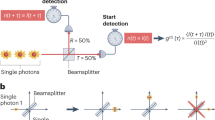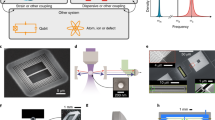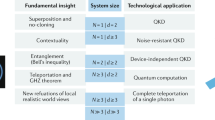Abstract
With the development of photonic quantum technologies, single photons have become key for various applications including quantum communication and quantum computing, discussed in an accompanying Review. Here we overview the applications of single photons in quantum metrology, biology and experiments probing the foundations of quantum physics. For each of these applications, we outline the main milestones reached so far, the remaining challenges, and the improvements that could be made in the future. We conclude with a wish list for future single-photon sources.
Key points
-
Detecting a single-photon or an N-photon state is not easy and requires specific detectors with precise calibration.
-
Quantum metrology with single photons can reach the ultimate limit in terms of metrology standards.
-
Natural biological systems, such as the human eye and processes in photosynthesis, are sensitive to the detection of single photons.
-
Single-photon experiments are used to test the limits of quantum mechanics and uncover connections to other theories such as general relativity.
This is a preview of subscription content, access via your institution
Access options
Access Nature and 54 other Nature Portfolio journals
Get Nature+, our best-value online-access subscription
$29.99 / 30 days
cancel any time
Subscribe to this journal
Receive 12 digital issues and online access to articles
$99.00 per year
only $8.25 per issue
Buy this article
- Purchase on Springer Link
- Instant access to full article PDF
Prices may be subject to local taxes which are calculated during checkout



Similar content being viewed by others
References
Couteau, C. et al. Applications of single photons to quantum communication and computing. Nat. Rev. Phys. https://doi.org/10.1038/s42254-023-00583-2 (2023).
Aharonovich, I., Englund, D. & Toth, M. Solid-state single-photon emitters. Nat. Photon. 10, 631–641 (2016).
Senellart, P., Solomon, G. & White, A. High-performance semiconductor quantum-dot single-photon sources. Nat. Nanotechnol. 12, 1026–1039 (2017).
Flamini, F., Spagnolo, N. & Sciarrino, F. Photonic quantum information processing: a review. Rep. Prog. Phys. 82, 016001 (2019).
Slussarenko, S. & Pryde, G. J. Photonic quantum information processing: a concise review featured. Appl. Phys. Rev. 6, 041303 (2019).
Lee, J. et al. Integrated single photon emitters. AVS Quantum Sci. 2, 031701 (2020).
Wang, H. et al. High-efficiency multiphoton boson sampling. Nat. Photon. 11, 361–365 (2017).
Abudayyeh, H. A. & Rapaport, R. Quantum emitters coupled to circular nanoantennas for high-brightness quantum light sources. Quantum Sci. Technol. 2, 034004 (2017).
Kaneda, F. & Kwiat, P. G. High-efficiency single-photon generation via large-scale active time multiplexing. Sci. Adv. 5, eaaw8586 (2019).
Tomm, N. et al. A bright and fast source of coherent single photons. Nat. Nanotechnol. 16, 399–403 (2021).
Sabines-Chesterking, J. et al. Twin-beam sub-shot-noise raster-scanning microscope. Opt. Express 27, 30810–30818 (2019).
Adesso, G. et al. Optimal estimation of losses at the ultimate quantum limit with non-Gaussian states. Phys. Rev. A 79, 040305 (2009).
Jakeman, E. & Rarity, J. G. The use of pair production processes to reduce quantum noise in transmission measurements. Opt. Commun. 59, 219–223 (1986).
Bondurant, R. S. & Shapiro, J. H. Squeezed states in phase-sensing interferometers. Phys. Rev. D 30, 2548–2556 (1984).
Aasi, J. et al. Enhanced sensitivity of the LIGO gravitational wave detector by using squeezed states of light. Nat. Photon. 7, 613–619 (2013).
Caves, C. M. Quantum-mechanical noise in an interferometer. Phys. Rev. D. 23, 1693–1708 (1981).
Ono, T., Okamoto, R. & Takeuchi, S. An entanglement-enhanced microscope. Nat. Commun. 4, 2426 (2013).
Rablau, C. LiDAR: a new self-driving vehicle for introducing optics to broader engineering and non-engineering audiences. In Fifteenth Conference on Education and Training in Optics and Photonics: ETOP 2019 Vol. 11143 (SPIE, 2019).
Reddy, D.V. et al. Exceeding 95% system efficiency within the telecom C-band in superconducting nanowire single photon detectors. In Conference on Lasers and Electro-Optics (IEEE, 2019).
Marsili, F. et al. Detecting single infrared photons with 93% system efficiency. Nat. Photon 7, 210–214 (2013).
Lita, A. E., Miller, A. J. & Nam, S. W. Counting near-infrared single-photons with 95% efficiency. Opt. Express 16, 3032–3040 (2008).
Wollman, E. E. et al. UV superconducting nanowire single-photon detectors with high efficiency, low noise, and 4 K operating temperature. Opt. Express 25, 26792–26801 (2017).
Giustina, M. et al. Bell violation using entangled photons without the fair-sampling assumption. Nature 497, 227–230 (2013).
Giustina, M. et al. Significant-loophole-free test of Bell’s theorem with entangled photons. Phys. Rev. Lett. 115, 250401 (2015).
Shalm, L. K. et al. Strong loophole-free test of local realism. Phys. Rev. Lett. 115, 250402 (2015).
Zhong, H.-S. et al. 12-photon entanglement and scalable scattershot boson sampling with optimal entangled-photon pairs from parametric down-conversion. Phys. Rev. Lett. 121, 250505 (2018).
Varnava, M., Browne, D. E. & Rudolph, T. How good must single photon sources and detectors be for efficient linear optical quantum computation? Phys. Rev. Lett. 100, 060502 (2008).
Cahall, C. et al. Multi-photon detection using a conventional superconducting nanowire single-photon detector. Optica 4, 1534–1535 (2017).
Kok, P. & Braunstein, S. L. Detection devices in entanglement-based optical state preparation. Phys. Rev. A 63, 033812 (2001).
Sahin, D. et al. in Superconducting Devices in Quantum Optics (eds Hadfield, R. H. & Johansson, G.) 61–83 (Springer, 2016).
Banaszek, K. & Walmsley, I. A. Photon counting with a loop detector. Opt. Lett. 28, 52–54 (2003).
Fitch, M. J. et al. Photon-number resolution using time-multiplexed single-photon detectors. Phys. Rev. A 68, 043814 (2003).
Gerrits, T. et al. in Superconducting Devices in Quantum Optics (eds Hadfield, R. H. & Johansson, G.) 31–60 (Springer, 2016).
Gerrits, T. et al. Extending single-photon optimized superconducting transition edge sensors beyond the single-photon counting regime. Opt. Express 20, 23798–23810 (2012).
Levine, Z. H. et al. Algorithm for finding clusters with a known distribution and its application to photon-number resolution using a superconducting transition-edge sensor. J. Opt. Soc. Am. B 29, 2066–2073 (2012).
Levine, Z. H. et al. Photon-number uncertainty in a superconducting transition edge sensor beyond resolved-photon-number determination. J. Opt. Soc. Am. B 31, B20–B24 (2014).
Burenkov, I. A. et al. Full statistical mode reconstruction of a light field via a photon-number-resolved measurement. Phys. Rev. A 95, 053806 (2017).
Goldschmidt, E. A. et al. Mode reconstruction of a light field by multiphoton statistics. Phys. Rev. A 88, 013822 (2013).
Gerry, C. & Knight, P. Introductory Quantum Optics (Cambridge Univ. Press, 2004).
Hanbury Brown, R. & Twiss, R. Q. A test of a new type of stellar interferometer on Sirius. Nature 178, 1046–1048 (1956).
Sturges, T. J. et al. Quantum simulations with multiphoton Fock states. npj Quantum Inf. 7, 91 (2021).
Scheel, S., Nemoto, K., Munro, W. J. & Knight, P. L. Measurement-induced nonlinearity in linear optics. Phys. Rev. A 68, 032310 (2003).
Ourjoumtsev, A. et al. Generating optical schrödinger kittens for quantum information processing. Science 312, 83–86 (2006).
Ourjoumtsev, A. et al. Generation of optical Schrödinger cats from photon number states. Nature 448, 784–786 (2007).
Gerrits, T. et al. Generation of optical coherent-state superpositions by number-resolved photon subtraction from the squeezed vacuum. Phys. Rev. A 82, 031802 (2010).
Wakui, K. et al. Photon subtracted squeezed states generated with periodically poled KTiOPO4. Opt. Express 15, 3568–3574 (2007).
Ralph, T. C. et al. Quantum computation with optical coherent states. Phys. Rev. A 68, 042319 (2003).
Lee, S.-Y. et al. Quantum phase estimation using a multi-headed cat state. J. Opt. Soc. Am. B 32, 1186–1192 (2015).
Dowling, J. P. Quantum optical metrology — the lowdown on high-N00N states. Contemp. Phys. 49, 125–143 (2008).
Matthews, J. C. F. et al. Towards practical quantum metrology with photon counting. npj Quantum Inf. 2, 16023 (2016).
Slussarenko, S. et al. Unconditional violation of the shot-noise limit in photonic quantum metrology. Nat. Photon. 11, 700–703 (2017).
You, C. et al. Multiphoton quantum metrology without pre-and post-selected measurements. in Frontiers in Optics and Laser Science APS/DLS (Optical Society of America, 2019).
Tsang, M. Conservative classical and quantum resolution limits for incoherent imaging. J. Mod. Opt. 65, 1385–1391 (2018).
Ansari, V. et al. Temporal-mode measurement tomography of a quantum pulse gate. Phys. Rev. A 96, 063817 (2017).
Korzh, B. et al. Demonstration of sub-3 ps temporal resolution with a superconducting nanowire single-photon detector. Nat. Photon. 14, 250–255 (2020).
Ebrey, T. & Koutalos, Y. Vertebrate photoreceptors. Prog. Retin. Eye Res. 20, 49–94 (2001).
Bialek, W. Biophysics: Searching for Principles (Princeton Univ. Press, 2012).
Dowling, J. E. The Retina (Harvard Univ. Press, 1987).
Hecht, S., Shlaer, S. & Pirenne, M. H. Energy, quanta, and vision. J. Gen. Physiol. 25, 819–840 (1942).
Sakitt, B. Counting every quantum. J. Physiol. 223, 131–150 (1972).
Teich, M. C., Prucnal, P. R., Vannucci, G., Breton, M. E. & McGill, W. J. Multiplication noise in the human visual system at threshold: 1 Quantum fluctuations and minimum detectable energy. J. Opt. Soc. Am. 72, 419–431 (1982).
Barlow, H. B. Retinal noise and absolute threshold. J. Opt. Soc. Am. 46, 634–639 (1956).
Rieke, F. & Baylor, D. A. Origin of reproducibility in the responses of retinal rods to single photons. Biophys. J. 75, 1836–1857 (1998).
Phan, N. M., Cheng, M. F., Bessarab, D. A. & Krivitsky, L. A. Interaction of fixed number of photons with retinal rod cells. Phys. Rev. Lett. 112, 213601 (2014).
Sim, N., Cheng, M. F., Bessarab, D., Jones, C. M. & Krivitsky, L. A. Measurement of photon statistics with live photoreceptor cells. Phys. Rev. Lett. 109, 113601 (2012).
Tinsley, J. N. et al. Direct detection of a single photon by humans. Nat. Commun. 7, 12172 (2016).
Arndt, M., Juffmann, T. & Vedral, V. Quantum physics meets biology. HFSP J. 3, 386 (2009).
Sharpe, L. T., Stockman, A., Fach, C. C. & Markstahler, U. Temporal and spatial summation in the human rod visual system. J. Physiol. 463, 325–348 (1993).
Holmes, R., Victora, M., Wang, R. F. & Kwiat, P. G. Measuring temporal summation in visual detection with a single-photon source. Vis. Res. 140, 33–43 (2017).
Rieke, F. & Baylor, D. A. Molecular origin of continuous dark noise in rod photoreceptors. Biophys. J. 71, 2553–2572 (1996).
Rieke, F. Seeing in the dark: retinal processing and absolute visual threshold. Senses A Compr. Ref. Vis. 1, 393–412 (2008).
Zeilinger, A. Experiment and the foundations of quantum physics. Rev. Mod. Phys. 71, S288 (1999).
Sekatski, P., Brunner, N., Branciard, C., Gisin, N. & Simon, C. Towards quantum experiments with human eyes as detectors based on cloning via stimulated emission. Phys. Rev. Lett. 103, 113601 (2009).
Brunner, N., Branciard, C. & Gisin, N. Possible entanglement detection with the naked eye. Phys. Rev. A 78, 052110 (2008).
Vivoli, V. C., Sekatski, P. & Sangouard, N. What does it take to detect entanglement with the human eye? Optica 3, 473–476 (2016).
van Grondelle, R. & Novoderezhkin, V. I. Energy transfer in photosynthesis: experimental insights and quantitative models. Phys. Chem. Chem. Phys. 8, 793–807 (2006).
Engel, G. S. et al. Evidence for wavelike energy transfer through quantum coherence in photosynthetic systems. Nature 446, 782–786 (2007).
Panitchayangkoon, G. et al. Long-lived quantum coherence in photosynthetic complexes at physiological temperature. Proc. Natl Acad. Sci. USA 107, 12766 (2010).
Hildner, R., Brinks, D., Nieder, J. B., Cogdell, R. J. & van Hulst, N. F. Quantum coherent energy transfer over varying pathways in single light-harvesting complexes. Science 340, 1448–1451 (2013).
Denk, W., Strickler, J. H. & Webb, W. W. Two-photon laser scanning fluorescence microscopy. Science 248, 73–76 (1990).
Helmchen, F. & Denk, W. Deep tissue two-photon microscopy. Nat. Methods 2, 932–940 (2005).
Dayan, B., Pe’er, A., Friesem, A. A. & Silberberg, Y. Nonlinear interactions with an ultrahigh flux of broadband entangled photons. Phys. Rev. Lett. 94, 043602 (2005).
Gea-Banacloche, J. Two-photon absorption of nonclassical light. Phys. Rev. Lett. 62, 1603 (1989).
Upton, L. et al. Optically excited entangled states in organic molecules illuminate the dark. J. Phys. Chem. Lett. 4, 2046–2052 (2013).
Villabona-Monsalve, J. P., Varnavski, O., Palfey, B. A. & Goodson, T. Two-photon excitation of flavins and flavoproteins with classical and quantum light. J. Am. Chem. Soc. 140, 14562–14566 (2018).
Kimble, H. J., Dagenais, M. & Mandel, L. Photon antibunching in resonance fluorescence. Phys. Rev. Lett. 39, 691 (1977).
Couteau, C. Spontaneous parametric down-conversion. Cont. Phys. 59, 291–304 (2018).
Kauten, T., Pressl, B., Kaufmann, T. & Weihs, G. Measurement and modeling of the nonlinearity of photovoltaic and Geiger-mode photodiodes. Rev. Sci. Instrum. 85, 063102 (2014).
Zeilinger, A., Weihs, G., Jennewein, T. & Aspelmeyer, M. Happy centenary, photon. Nature 433, 230–238 (2005).
Sorkin, R. D. Quantum mechanics as quantum measure theory. Mod. Phys. Lett. A 9, 3119–3127 (1994).
Sinha, U., Couteau, C., Jennewein, T., Laflamme, R. & Weihs, G. Ruling out multi-order interference in quantum mechanics. Science 329, 418–421 (2010).
Hickmann, J. M., Fonseca, E. J. S. & Jesus-Silva, A. J. Born’s rule and the interference of photons with orbital angular momentum by a triangular slit. Europhys. Lett. 96, 64006 (2011).
Kauten, T. et al. Obtaining tight bounds on higher-order interferences with a 5-path interferometer. N. J. Phys. 19, 033017 (2017).
Adler, S. L. Quaternionic Quantum Mechanics and Quantum Fields. International Series of Monographs on Physics Vol. 88 (Oxford Univ. Press, 1995).
Peres, A. Proposed test for complex versus quaternion quantum theory. Phys. Rev. Lett. 42, 683 (1979).
Procopio, L. M. et al. Single-photon test of hyper-complex quantum theories using a metamaterial. Nat. Commun. 8, 15044 (2017).
Adler, S. L. Peres experiment using photons: no test for hypercomplex (quaternionic) quantum theories. Phys. Rev. A 95, 060101 (2017).
Procopio, L. M., Rozema, L. A., Dakic, B. & Walther, P. Comment on ‘Peres experiment using photons: no test for hypercomplex (quaternionic) quantum theories’. Phys. Rev. A 96, 036101 (2017).
Steinberg, A. M., Kwiat, P. G. & Chiao, R. Y. Measurement of the single-photon tunneling time. Phys. Rev. Lett. 71, 708 (1993).
Kwiat, P. G. & Chiao, R. Y. Observation of a nonclassical Berry’s phase for the photon. Phys. Rev. Lett. 66, 588 (1991).
Aharonov, Y., Albert, D. Z. & Vaidman, L. How the result of a measurement of a component of the spin of a spin-1/2 particle can turn out to be 100. Phys. Rev. Lett. 60, 1351 (1988).
Dressel, J., Malik, M., Miatto, F. M., Jordan, A. N. & Boyd, R. W. Colloquium: understanding quantum weak values: basics and applications. Rev. Mod. Phys. 86, 307 (2014).
Kocsis, S. et al. Observing the average trajectories of single photons in a two-slit interferometer. Science 332, 1170–1173 (2011).
Bliokh, K., Bekshaev, A., Kofman, A. G. & Nori, F. Photon trajectories, anomalous velocities and weak measurements: a classical interpretation. N. J. Phys. 15, 073022 (2013).
Chrapkiewicz, R., Jachura, M., Banaszek, K. & Wasilewski, W. Hologram of a single photon. Nat. Photon. 10, 577–579 (2016).
Holland, P. R. The Quantum Theory of Motion: An Account of the de Broglie–Bohm Causal Interpretation of Quantum Mechanics (Cambridge Univ. Press, 1993).
Bohm, D., Hiley, B. J. & Kaloyerou, P. N. A causal interpretation of quantum fields. Phys. Rep. 6, 349 (1987).
Hosten, O. & Kwiat, P. Observation of the spin Hall effect of light via weak measurements. Science 319, 787–790 (2008).
Onoda, M., Murakami, S. & Nagaosa, N. Hall effect of light. Phys. Rev. Lett. 93, 083901 (2004).
Heisenberg, W. The Physical Principles of the Quantum Theory (Univ. Chicago Press, 1930).
Ozawa, M. Universally valid reformulation of the Heisenberg uncertainty principle on noise and disturbance in measurement. Phys. Rev. A 67, 042105 (2003).
Rozema, L. A. et al. Violation of Heisenberg’s measurement–disturbance relationship by weak measurements. Phys. Rev. Lett. 109, 100404 (2012).
Branciard, C. Error-tradeoff and error-disturbance relations for incompatible quantum measurements. Proc. Natl Acad. Sci. USA 110, 6742–6747 (2013).
Ringbauer, M. et al. Experimental joint quantum measurements with minimum uncertainty. Phys. Rev. Lett. 112, 020401 (2014).
Hilweg, C. et al. Gravitationally induced phase shift on a single photon. N. J. Phys. 19, 033028 (2017).
Faccio, D., Velten, A. & Wetzstein, G. Non-line-of-sight imaging. Nat. Rev. Phys. 2, 318–327 (2020).
Whittaker, R. et al. Absorption spectroscopy at the ultimate quantum limit from single-photon states. N. J. Phys. 19, 033028 (2017).
Kandel, E. R., Schwartz, J. H., Jessell, T. M., Siegelbaum, S. A. & Hudspeth, A. J. Principles of Neural Science 5th edn, Chapter 26 (McGraw-Hill, 2012).
Mirkovic, T. Light absorption and energy transfer in the antenna complexes of photosynthetic organisms. Chem. Rev. 117, 249–293 (2016).
Acknowledgements
C.C. and T.D. thank the COST Action MP1403 ‘Nanoscale Quantum Optics’, supported by COST (European Cooperation in Science and Technology). C.C. thanks the Graduate School NANO-PHOT ANR project. R.P. was supported by the European Molecular Biology Laboratory. G.W. acknowledges support by the Austrian Science Fund FWF, project F7114 (SFB BeyondC).
Author information
Authors and Affiliations
Contributions
All authors contributed to discussing and writing the article. C.C. coordinated the contributions and provided oversight.
Corresponding author
Ethics declarations
Competing interests
The authors declare no competing interests.
Peer review
Peer review information
Nature Reviews Physics thanks Igor Aharonovich, Stéphane Clemmen, Peter Lodahl and Pascale Senellart for their contribution to the peer review of this work.
Additional information
Publisher’s note Springer Nature remains neutral with regard to jurisdictional claims in published maps and institutional affiliations.
Supplementary information
Rights and permissions
Springer Nature or its licensor (e.g. a society or other partner) holds exclusive rights to this article under a publishing agreement with the author(s) or other rightsholder(s); author self-archiving of the accepted manuscript version of this article is solely governed by the terms of such publishing agreement and applicable law.
About this article
Cite this article
Couteau, C., Barz, S., Durt, T. et al. Applications of single photons in quantum metrology, biology and the foundations of quantum physics. Nat Rev Phys 5, 354–363 (2023). https://doi.org/10.1038/s42254-023-00589-w
Accepted:
Published:
Issue Date:
DOI: https://doi.org/10.1038/s42254-023-00589-w
This article is cited by
-
Perfect single-photon sources
Scientific Reports (2024)
-
Applications of single photons to quantum communication and computing
Nature Reviews Physics (2023)



